Washington, D.C. was our entire holiday in microcosm: big fun, but over-ambitious.
We lived in Baltimore when I was quite young, 1958-1960. DC was a day-trip. Of course our parents took us there, probably more than once. My sister, two years older, retains a vague recollection. But though I remember Atlantic City (Boardwalk, diving horse, salt-water taffy, dizzying waves that knocked me on my barely-more-than-a-toddler butt at the ocean’s edge) and our late autumn, extended-family trip to New York (Automat, skyscrapers, ferry, Statue of Liberty), I have no memory of this,
or this,
or this.
But I’m getting ahead of myself. Eye-opener #1 was Union Station.
Have you noticed that most of the stations I mention are named “Union?” If you’re taking a tally, it’s 4-out-of-5: Houston’s original, Albany, Tampa, and now DC. New York City is the exception. It has a Union Square subway station, but that hardly qualifies. All inter-city trains use Pennsylvania, Grand Central, 14th St., Long Island, or the Port Authority.
I checked it out. There are 121 Union Stations in the USA. I assumed it had something to do with the Union Pacific Railroad. Totally wrong. “Union” isn’t a brand. It’s a description. Called a union terminal or joint station in Europe, a union station has tracks and facilities that are shared by two or more railway companies, allowing passengers to connect between them with ease.
Not all Union Stations are created equal. Albany’s was sweet, Tampa’s was not. Houston’s has been re-purposed. Washington’s? Absolutely stunning.
It has to be, I suppose, to fit in with the rest of DC. My face was glued to the window on the taxi ride to our hotel. Elegant, important-looking buildings and elegant, self-important trees grace the entire, Kabbalistic municipal layout. Long, diagonal avenues converge at public-park roundabouts, each adorned with an appropriate statue or fountain. Many of the architectural wonders are federal and official,
others are the DC version of emporiums and businesses you see all over America, like this oh-so ornate Forever 21.
No matter where I looked, it seemed some iconic national monument or other was in view. More often than not, it was this monument.
Washington’s giganto obelisk easily manages to photobomb more snapshots than any other landmark.
The city has a surprisingly smooth flow, an aura of stability, a metropolitan coherence that contrasts dramatically – but not sharply – with the Big Apple’s frenzied pace and gloriously excessive diversity. DC is just plain beautiful.
Roy had booked us two nights’ accommodation at the posh Kimpton-Carlyle in the Dupont Circle part of town,
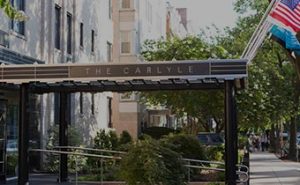
giving us two half-days and one entirely free no-travel day in our nation’s capital. The hotel was brilliant, and our room –
so cushy, so comfy. So private. And it only took us a few tries to get the hang of using the touch-card key.
DC isn’t the only town using touch-card technology. It just happened to be the first town we encountered it. In case it’s also new to you, here’s the skinny. Instead of inserting your card-key into a card-reader attached to the hotel room door handle, or popping your card-pass into a slot in the subway turnstile, or simply punching a button in the hotel elevator, you press the card to a sensor – and the door opens, the turnstile parts (in DC, they’re not actually turn stiles),
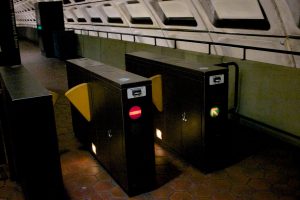
and the elevator consents to ascend/descend.
We were suitably impressed.
Before taking off to see some sights, we picked a place for dinner. Roy is not half-bad at online restaurant searches, and I’m dang good at it. Our mad skills weren’t needed in DC, however, thanks to the Eater’s website: The 38 Essential D.C. Restaurants. (The link takes you to the summer version. We were on the Spring 2017 pages; the site updates quarterly.) Eater not only provides a comprehensive list of top choices, it reviews them and displays them on an interactive map, allowing searchers to sift through the recommendations by location.
Early June, the days are long and evenings linger. Fun fact: the day-night ratio in DC and Sonoma are just about identical. They share the same latitude, 38.2919° N (Sonoma) and 38.9072° N (Washington).
The feel of the place, though . . . the moisture in the air, the scent of the earth, the warm nights in DC were nothing like early summer in Northern California – and yet, they were ineffably familiar to me. I didn’t consciously catalogue my seasonal sensations when I was a little girl in Baltimore, but stepping onto the streets of DC, a dormant sensory awareness woke to happy consciousness within me, and a small voice inside sighed, “I’m home!”
I have an excellent sense of direction, which DC repeatedly managed to derail. Diagonal avenues didn’t feel diagonal when I was strolling along them, and that illusion made the non-diagonal streets appear to intersect at an angle. Luckily, Roy knew his way around town from his army days, when he’d been stationed at nearby Fort Belvoir. He led me to and through Dupont Circle, then down Connecticut Ave (big business and shopping) to Farragut Square.
Another Fun Fact: Admiral David Farragut, American war hero famed for his service to the Union during the Civil War (“Damn the torpedoes, full speed ahead!”), was not born FAYR uh gut, but farr uh GOOT. His ancestry was half-Scottish and half-Spanish – and we’re betting he wasn’t so much half-Spanish as half-Catalan. Què et sembla?
A few more blocks, a few more corners, and . . .
The thing about seeing something thousands of times in films, newspapers, magazines, books, online, and on TV, is that when you see it in person, it doesn’t seem real. 1600 Pennsylvania Ave NW. The White House. I couldn’t believe it. I peered through the iron rails, snapped my pics, helped others snap their pics, and it was grand . . . but I couldn’t shake the feeling I should be picketing instead of ogling.
We dined at Zaytinya – a José Andrés restaurant.
I had no idea what “a José Andrés restaurant” meant at the time. Now I’m enlightened. José Andrés is the guy credited with bringing tapas (small-plate cuisine) to the States. At Zaytinya, the focus is on Greek, Lebanese, and Turkish dishes. His other restaurants – and his food truck – have their own specialties. Jaleo, also in DC, serves traditional Spanish tapas. ChinaPoblano in Las Vegas is Chinese/Mexican fusion. He does Fish in Maryland, Tres is a bistro in Beverly Hills, and Beefsteak, with five locations, serves “vegetables unleashed.”
All of the above and more are part of Andrés’ ThinkFood Group, an innovative company of restaurants, hotels, food products, media, educational initiatives, and philanthropy. Through TFG, Andrés labors to improve the community by supporting D.C. Central Kitchen, World Central Kitchen, and other worthwhile causes. An immigrant himself (from Spain), Andrés pulled out of a 2-years-in-development deal to open a restaurant in #45’s DC hotel when the then-candidate starting spouting anti-immigrant rhetoric. Im-POTUS’s spawn promptly sued; Andrés counter-sued for $8 mil. It’s a delicious story, read it HERE.
That dinner was, beyond question, one of the most amazing meals of my life. Zaytinya serves an impressive array of inventive drinks, fine wines, and Mediterranean mezes. It is modern, marvelous, huge – and the place was packed. This was a Tuesday night, mind. Not a big night for restaurants in most parts of the country, but if New York is the City That Never Sleeps, DC is the City That Never Never Stops Eating/Drinking at High-End Establishments. Yes, ok, not very pithy. But true.
Ignorant of the whole José Andrés thing, how Zatinya worked, and who was the boss of the meal, Roy and I initially tried to influence the order of our courses. No, no, no. Our waiter was tolerant, but not indulgent. Evidently only boors presume to dictate to this kitchen. If you are not going to allow the Chef to select your entire menu (yes, that’s an option), you must at least give him leave to stage the courses as he deems best.
And really, you must. They do know best. Not only were the dishes individually divine, the seamless succession of dishes was the gustatory equivalent of an orgasmic experience. My favorite tapa was the Mercimek Köftesi. I cannot begin to tell you what made a couple of small, seared red lentil patties, a few dollops of lemon yogurt, and a scattering of pomegranate seeds on a bed of lettuce so special. All I can say is, I’ve never tasted anything so delicious.
Our only oops was in following the waiter’s suggestion to order three plates each for a total of six. We were full by the fourth and so stuffed by the fifth, we couldn’t finish the last and had to take most of it with us. Tragic . . . although the goat did make a fabulous breakfast.
It was raining when we (finally) left. The shower was warm and summery, but we wisely picked up an umbrella at a nearby drugstore before taking a short stroll along the rain-washed streets and through the United States Naval Memorial
to the National Mall. Roy wanted me to see it at night, all lit up. He was right, it was wonderful,
but the trek to the Capitol Building proved too much for me.
It had been a hella-long day. The Mall’s sandy paths were sandy mud, and this pair of shoes had to last me. My hip was hurting (I’d kinda pulled something before we’d left home, maybe my psoas, and with all the travel-related walking, lugging, lifting, and hauling, it was giving me some serious grief). We hadn’t even reached Grant’s Memorial when I called a halt. I was done. We headed for the Metro.
The DC Metro is – guess what. Totally gorgeous.
Thanks to a kind and helpful station attendant, we eventually got the right passes, made it through the touch-card turnstile, and boarded a Washington Metropolitan Area Transit Authority (WMATA) train. Navigating the Metro was easy. I just stuck this map in my phone,
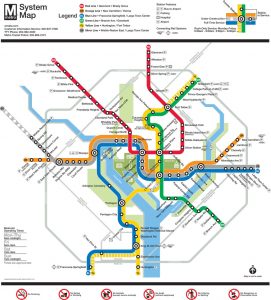
and we were good-to-go anytime, anywhere.
If Tuesday was a long day, Wednesday was a marathon.
America has a lot to be ashamed of lately, but one thing we can be genuinely proud of is the Smithsonian Institution – the world’s largest museum, education, and research complex. The Smithsonian has eleven separate museums and galleries on the National Mall, six museums and the National Zoo in the National Capital Area, two historic-settings museums in New York City, and they send exhibitions on tour all the time. It’s a national treasure. Our treasure. It belongs to us. We can go there anytime we want. For free.
The must-see these days is the newest addition to the Smithsonian family: the African-American Museum. By all accounts it is amazing. It is also so popular you must reserve your admission in advance. When we looked into it last March, they were taking reservations for October. We have it on good authority that you can get in same-day on standby, but we had other plans. Here in the beating national heart of America, it seemed altogether fitting and proper to remember that our nation was born from the original sins of racial genocide and land theft. If we only had time for one museum, it was going to be the National Museum of the American Indian.
The name has a politically-incorrect ring to it, but the place itself truly honors the continent’s First Peoples. For me, the exterior conjures the spirit of the ancient Anasazi dwellings in America’s southwest,
while the interior evokes a visceral, spiritual awareness and connectivity to earth, air, and sky that transcends race and religion.
We began with Who We Are, a film by and about Native Americans shown in a round theatre, projected onto hides, and set to a traditional-music soundtrack. We spent the longest in Our Universes: Traditional Knowledge Shapes Our World, an exhibition exploring Native cosmology and featuring the Mapuche (Chile), Lakota (South Dakota), Quechua (Peru), Yup’ik (Alaska), Q’eq’chi, Maya (Guatemala), Santa Clara Pueblo (New Mexico), Anishinaabe (Hollow Water, Manitoba, Canada), and Hupa (California) communities.
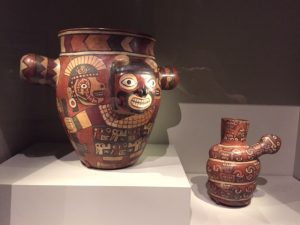
We listened to folktales. We chatted with the guy demonstrating traditional feathered-headband construction. We wandered through an enthralling portrait gallery: For a Love of His People: The Photography of Horace Poolaw. We vicariously travelled The Great Inka Road. The only exhibition I couldn’t handle was Nation to Nation: Treaties Between the United States and American Indian Nations. Broken treaties, that’s the thing. In less than two minutes, I was so sick with anger, I had to leave.
We ate at the museum café – Mitsitam (“Let’s Eat!” in the language of the Delaware and Piscataway peoples) – where Native-inspired cuisines from the Northern Woodlands, South America, the Northwest Coast, Meso America, and the Great Plains are on the menu. A guy behind one of the counters gave us so many tastes of crawfish stew and other delights, we were nearly full before we sat down to eat. Here is Mitsitam (behind the windows on the lowest level) from the outside looking in.
And here’s where we were (marker #4) in the grand scheme of the long stretch of DC greensward that is the National Mall (click this or any pic to enlarge).
We’d walked there, remember. Now, from there, we walked to the Washington Monument (#25), then to the WWII Memorial (#23), to the Vietnam Veterans Memorial (#24), to the Lincoln Memorial (#20), to the Korean War Memorial (#19), along the banks of the Potomac to the Jefferson Memorial (#22), then all the way across the Mall to the Federal Triangle Metro station. We took the Metro to Logan Circle, and then walked to Le Diplomate, which was still serving dinner at 10:30pm on a Wednesday night. And then we walked back to our hotel. Fair cop, it wasn’t a marathon (26.2188 miles/42.195 kilometres). But it was an 11-12 mile/17-19 kilometre day – which would have been quite a distance even if my hip hadn’t been bugging me.
Like I said, over-ambitious. But like I also said, big fun.
The summer-green Mall was bustling with people, some picnicking, some engaged in organized team sports, some playing a casual game of Frisbee, and many sightseeing, like us. As we passed the carousel and Smithsonian Castle (#14),
it started to sprinkle. Moments later, it was raining hard. Après cela, le déluge.
Naturally, we had forgotten to bring the umbrella we’d bought the night before. What we once knew, but had clearly forgotten, was that in this part of the world, it’s wise to carry an umbrella at all times. In California, if it rains, it rains big time, and our external brains (smart-phones) tell us “RAIN” today. On the East Coast, it may rain for 20 minutes, and for a mere 20 minutes, smart-phones can’t be bothered. “SUN” our weather apps told us. And we fell for it.
We walked in the rain for a while, but when it increased to the point we felt we were showering with our clothes on, we took shelter under a tree. That worked for a bit, but the rain was, as they say, coming down in buckets. A guy walked past us, out in the open, totally soaked. “I don’t even care anymore,” he laughed.
Soon we could see the edge of the squall in the distance. Like watching a pot boil, we watched the stormclouds pass overhead, the blue skies draw near, the percolating puddles slowly still. People emerged from their hiding places, the crowds returned to the lawn . . . and it was as if the storm had been a dream.
With every step we took, the Washington Monument grew taller. And taller. And outrageously, pompously, ridiculously taller.
Who decided a massive phallic column was a fitting memorial to our first president and an appropriate symbol to display to the world at large?
Glad you asked, because it ties-in. In an earlier post I reported that French architect Joseph-Jacques Ramée was responsible for the layout and architecture of Washington, D.C. Now I rather think that was Union College hyperbole.
The District of Columbia was created in 1790; Federal City – later renamed “the City of Washington” – was founded the next year on a site east of Georgetown. The design was done by French engineer and erstwhile Major in the Continental Army, Pierre Charles L’Enfant.
Though Ramée did not design DC, he did submit a drawing to the Washington Monument competition.
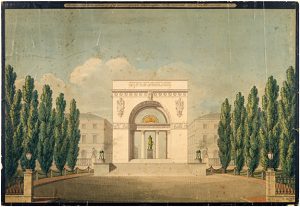
Joseph-Jacques Ramée, 1813.
Baltimore City Life Museum Collection
His was one of many submissions rejected by the adjudicating committee. You can read the whole fascinating story of the monument competition HERE. For better or worse (I’d say the latter), South Carolina architect Robert Mills won the contest. So, the answer to my question is, a bunch of (male) judges decided a gargantuan phallus best represented the legacy of America’s first president and was a fitting symbol for the young (and virile?) nation.
Roy and I agreed this sign, posted along the pathway to the monument, was a fitting symbol for our nation today.
The indefinite delay is to upgrade the elevator. Fans of the recently released Spider-Man Homecoming will find this particularly amusing.
Both the view and the wind were powerful at the top of the rise. To the east was the Capitol Building, with the vast carpet of the National Mall spread before it. To the west were more war memorials, and in the distance, Lincoln’s own. DC is positively littered with military monuments – statues, memorials, plaques, plazas . . . it was both stirring and depressing. So brief a time as a nation, and yet, so many wars.
The World War II Memorial was classical in style, impressive in scale. Pools and fountains, an awesome view of the obelisk, and stone wreaths for those who served draped on pillars representing the states.
On the far side of the Washington Monument, the National Mall is a well-ordered oblong bordered by Smithsonian museums and other buildings of cultural and political import. On this side, while there are straight paths,
there are also winding ways, and a more park-like feel. Roy took us up and along these paths until we came to the Vietnam Veterans Memorial.
Maya Lin was a 21-year-old student at Yale when her design for the black stone Veterans Memorial Wall won the largest design competition in American history. It is an incredible and incredibly moving work of art.
The two long walls of gabbro rock (dark, coarse-grained igneous) meet at an angle, forming an “open wound.”
You enter the memorial at the edges, where the wall is just 8 inches (200 millimeters) high, and descend with the wall as it sinks into the earth. At its apex it is 10.1 feet (3.1 meters); though the field stretches behind you, you feel you are standing in a vast grave. The names of the dead and the missing cover every inch of the wall – 58,318 troops. Look on it, you see your reflection and the names simultaneously, a poignant connection of past, present, and self.
Both the photos above are free-use. While the memorial is often quiet, relatively deserted, a solemn place where the veterans of this devastating conflict and their families can remember and mourn in peace, we were there during graduation week. It was a madhouse.
Middle school and high school graduates from all over the nation were celebrating with field trips to DC. This history meant nothing to them; we had to swim against a tide of loud, socially distracted, oblivious teens to find the slab and find the name Roy had come to see.
The raw, irrepressible emotion of that moment took us both by surprise. Roy wept. I wept to see him weep; I put my arm around him. Only one man seemed to see the Vietnam vet standing there, overcome. He reached for Roy’s hand, offered his sympathy, and thanked Roy for his service.
Remembering our brief moments there, I weep again. The memorial is profound. Like all great art, it slips right past your rational awareness and stirs your heart, your blood, your breath in ways you cannot control. Lin’s work is so powerful, I am at a loss as to why its construction and design were so controversial. Some complained. They were miffed that other vets got a representational-figure monument, while the Vietnam vets just got a wall. And that’s why a pathetically inferior Three Servicemen Memorial was constructed not far away. Not worth a pic, to my mind.
I might have appreciated the Lincoln Memorial more if it hadn’t also been horrifically packed with teens doing stunts on the stairs and if the noise of the crowd hadn’t echoed quite so loudly in the interior. It was dusky and grand, but sombre and cold. And seeing the girl who should have been wearing her school’s red T-shirt like the rest of her class, but instead was wearing a red “Make America Great Again” T-shirt really put a damper on my Lincoln experience. Somehow it seemed insulting attire, considering the contrasting morals of the man the shirt represents and the man the place honors.
We wandered into the Korean War Memorial rather by accident. I think that’s how the artist would have wanted it. You’re walking along, and suddenly you’re side-by-side with a unit slogging through a Korean field.
The path along the Potomac on the way to the Jefferson Memorial was lovely.
The view from the bridge, likewise.
This memorial has always been Roy’s favorite. He would go there for some quiet meditation, to center, to think. As far as monuments to founding fathers go, I agree; this one’s the best. With classic elegance, it achieves a marvelous balance between the natural beauty outside and the grandeur inside; the two environments mingle where they meet.
I loved the peacefulness, the marble benches, the magnificent statue.
Best I loved the words engraved on the walls. Four quotations from an eminently quotable man. This was my favorite.
Coming out of the Metro on our way to dinner, we happened on yet another memorial – to Black Servicemen. The right neighbourhood, perhaps . . . but couldn’t it do with a more prominent location?
Our pick that night was Le Diplomate. This suave French café serves dinner till 11:00pm most nights and till midnight Fridays and Saturdays. It has a famous bar, amazing décor, and the place was absolutely rocking. The wine/beer/cocktail list was formidable, our server was a delight (she’s gone by now, off to intern on her way to becoming a doctor!), and the food was terrific.
But we had overdone it. Despite that we had some hours to kill before our train, the next (hot) day all we could manage was to shuffle to the P.O. to mail some postcards and shuffle down our usual street in search of something to eat. Our gams were done for. We rolled our bags to the Metro (this is my Farewell to DC shot, looking up the escalator at the Dupont Circle Metro entrance/exit),
and headed for Union Station. We were weary, but resolved. We mean to return some day, stay longer, do all the museums, and knock off a few more of those “essential 38.” DC deserves more than a day.

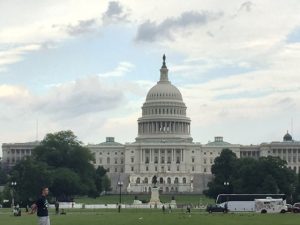
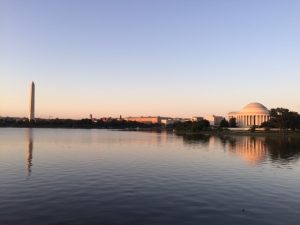
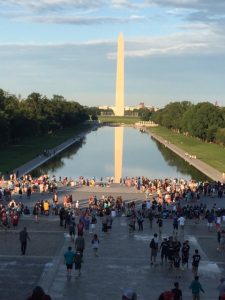
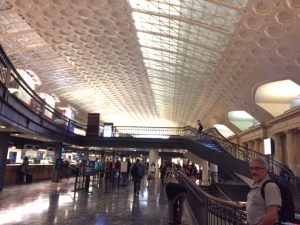
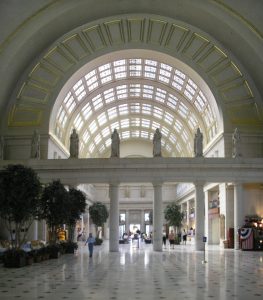
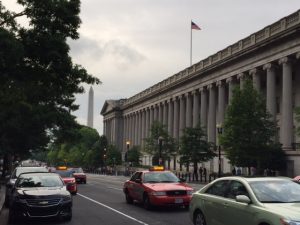
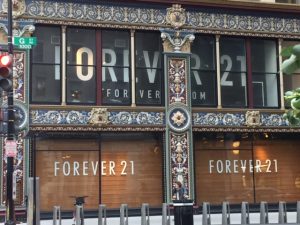
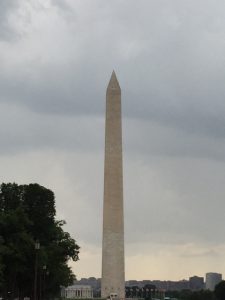
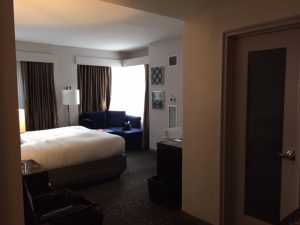
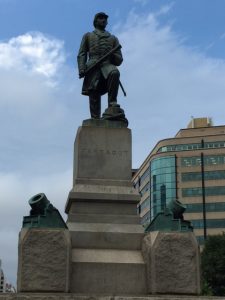
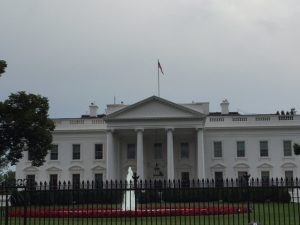
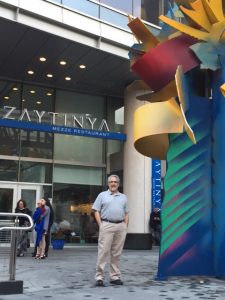
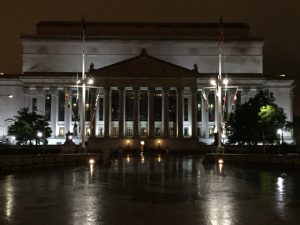
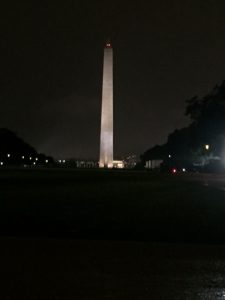
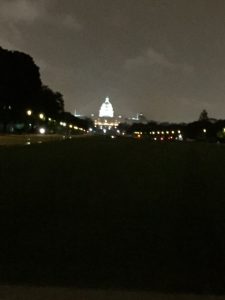
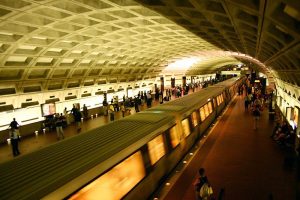
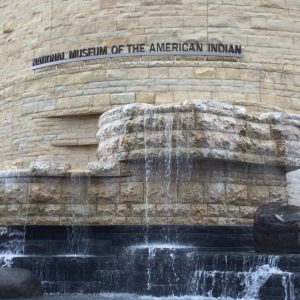
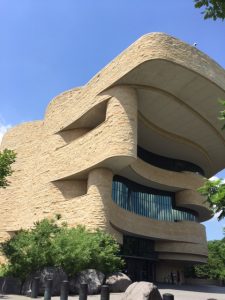
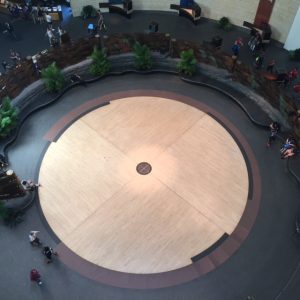
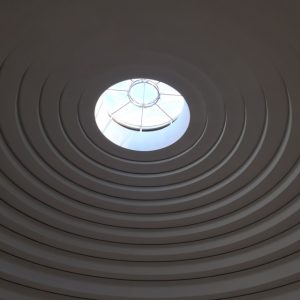
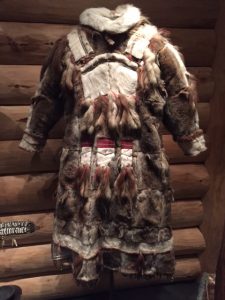
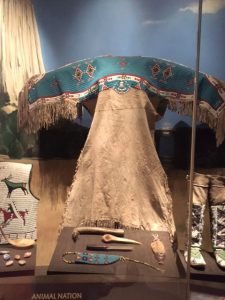
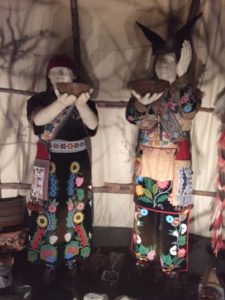
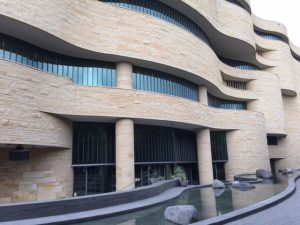
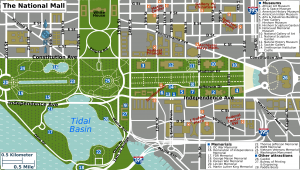
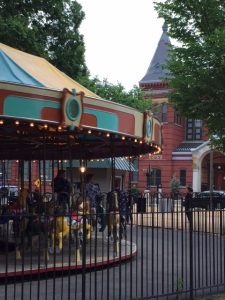
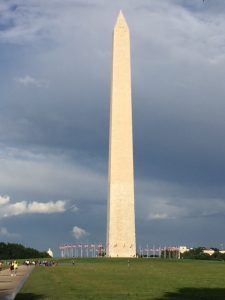
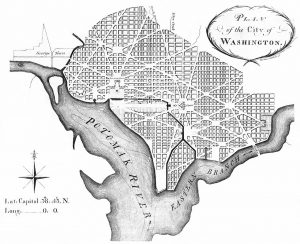

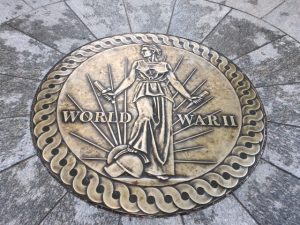
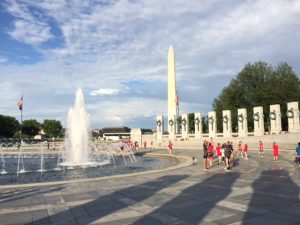
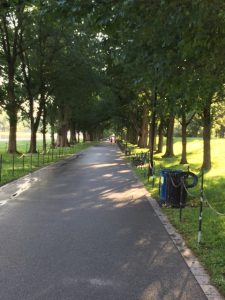
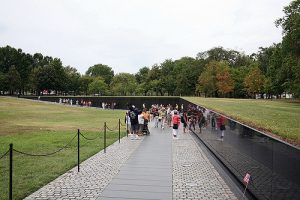
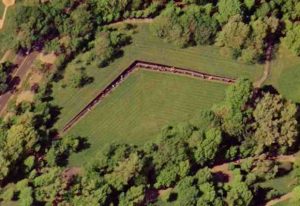
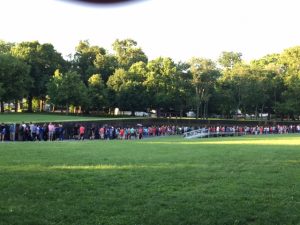
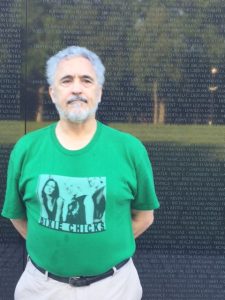
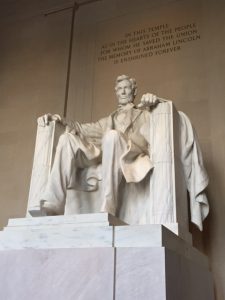

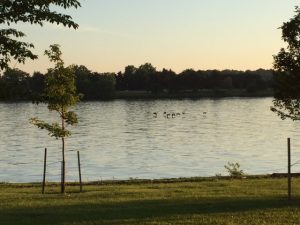
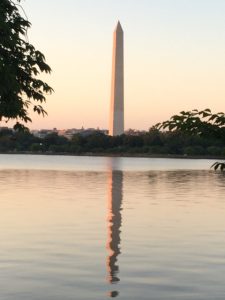
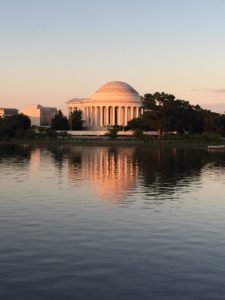
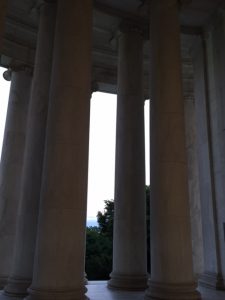
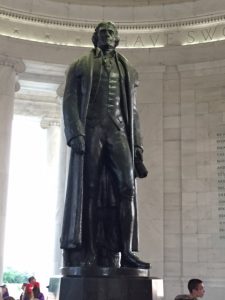
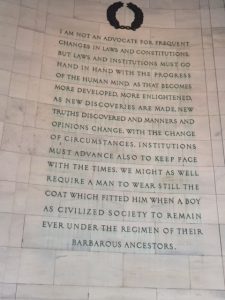
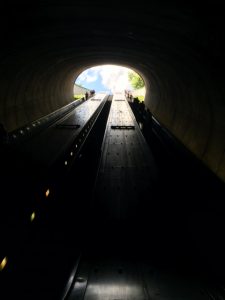
Wow! Some of your best blog writing ever. I hung on every word. Didn’t know anyone could make 45’s DC palatable, but you did. I was so moved by your description of yours and Roy’s experience at the Vietnam Memorial.
My feet hurt by the time i got to the end of the blog, though. You and Roy are a hearty breed!
Thanks so much! So glad you liked it, because I really wanted to do right by DC. It was so unexpectedly lovely. I have such distaste for what’s been going on in the halls of government pretty much since the Vietnam days, it became an ugly place to me – sight unseen. The pics I didn’t post . . . just walking you’re always happening on amazing classical and what is apparently Richardsonian Romanesque architecture (how could so much of DC be in this style, when the style only lasted about 20 years?), and so many buildings are official in some way. Check out this one HERE, and check out the statue in front – this is the Kazakhstan Embassy.